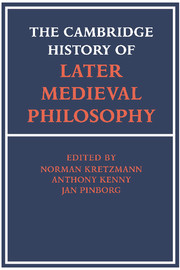 The Cambridge History of Later Medieval Philosophy
The Cambridge History of Later Medieval Philosophy from IV - Logic in the high middle ages: semantic theory
Published online by Cambridge University Press: 28 March 2008
A grammatical distinction between categoremata and syncategoremata
The paradigm of the categorical proposition with which medieval logicians were primarily concerned is a sentence of two words that serve as the subject term and the predicate term – e.g., ‘Socrates currit.’ Any word that can be used alone as a subject term or as a predicate term is classifiable as a categorematic word; all other words are classifiable as syncategorematic words, those that can occur in a proposition, whether categorical or hypothetical, only along with at least one properly matched pair of categorematic words – e.g., ‘Solus Socrates currit,’ ‘Socrates currit contingenter’, ‘Socrates non currit’, “Si Socrates currit, Socrates movetur.’ Drawing the distinction between categoremata and syncategoremata along this line, which seems to have been the original line of distinction, produces mutually exclusive and jointly exhaustive classes that coincide almost perfectly with certain groupings of the parts of speech (parts orationis) recognized by medieval grammarians: the names (both substantival and adjectivel), the personal and demonstrative pronouns and the verbs (excluding auxiliary verbs); the syncategoremate are all the others – e.g., the conjunction adverbs, and prepositions.
The logicians' notion of syncategoremata
The notice of synacategoremata that became important in medieval logic was, however, both narrower and broader than that comparatively orderly classification in terms of the parts of speech. Although more than fifty different words were considered in one or another medieval logicians' treatment of syncategoremate, by no means all non categorematic words in even the relatively small classes, such as conjunctions, were of enough interest to the logicians to be treated expressly among their syncategoremata.
To save this book to your Kindle, first ensure [email protected] is added to your Approved Personal Document E-mail List under your Personal Document Settings on the Manage Your Content and Devices page of your Amazon account. Then enter the ‘name’ part of your Kindle email address below. Find out more about saving to your Kindle.
Note you can select to save to either the @free.kindle.com or @kindle.com variations. ‘@free.kindle.com’ emails are free but can only be saved to your device when it is connected to wi-fi. ‘@kindle.com’ emails can be delivered even when you are not connected to wi-fi, but note that service fees apply.
Find out more about the Kindle Personal Document Service.
To save content items to your account, please confirm that you agree to abide by our usage policies. If this is the first time you use this feature, you will be asked to authorise Cambridge Core to connect with your account. Find out more about saving content to Dropbox.
To save content items to your account, please confirm that you agree to abide by our usage policies. If this is the first time you use this feature, you will be asked to authorise Cambridge Core to connect with your account. Find out more about saving content to Google Drive.